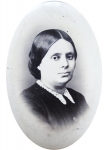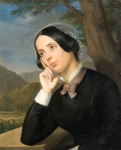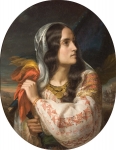Effingham Grant and Maria Rosetti
Between 1837-1859, the Scot Robert Gilmour Colquhoun was appointed Consul-General in Bucharest, and proved to be very influential in Romanian society. From 1837, Effingham Grant was appointed secretary at the Foreign Office. In his Memorandum of 4 November, 1851, addressed to Lord Henry Palmerston (Secretary of State for Foreign Affairs), Colquhoun mentions selecting E. Grant as secretary: “Beginning with the year 1837, we appointed Mr. Effingham Grant, at the time only 16, the only son of army Captain Grant, to assist me. Since then, he has been attached to my office, he has become very competent in French, German, Italian, Greek and Romanian; I have, on several occasions, assigned him official duties of a very delicate nature, particularly in 1848 and 1849, which he accomplished to my satisfaction, Your Excellency can rest assured in this respect.”
It appears that the Grant family belonged to a clan called ‘Grant of Cannon’ of Grantown-on-Spey, a little town in the County of Moray, in Scotland, but there are no documents to support this claim. Effingham, born in 1820, and his sister Mary, who was a year older, and whom he invited to Bucharest, were the children of Captain Edward Grant, a ship-owning resident of the Island of Guernsey, in the English Channel, and his French wife Marie Lavasseur. After arriving in Bucharest, Mary became the tutor of Colonel Ion Odobescu’s children (who was living in the Bucharest area of Curtea Veche and then Icoanei). Mary married C. A. Rosetti, a friend of her brother’s, on 31 August 1847, in Plymouth, England, then in Vienna, with Alexandru and Ștefan Golescu as godfathers.
Mary Grant, who became Maria Rosetti, was to play a prominent part in Romanian society. Her actions in support of the 1848 revolution were praised by Jules Michelet in his article Principautés danubiennes: Madame Rosetti, published in L’Evénement, Paris 1851. Disguised in a Romanian folk costume and accompanied by the painter C. D. Rosenthal who was a close friend of her husband’s, she went on board the ship which held as prisoners her husband and also Nicolae Bălcescu, Ion Ionescu de la Brad and Dimitrie Bolintineanu. She also brought along her new-born baby girl Libertatea Sofia and she asked the guards for permission to kiss her husband. While doing so, she slipped a little note into her husband’s mouth, with the details of when and where the revolutionaries would be released. Their plan succeeded and the Rosettis then lived for 9 years in exile, in Paris. There, Maria Rosetti collaborated with La Presse, the French newspaper.
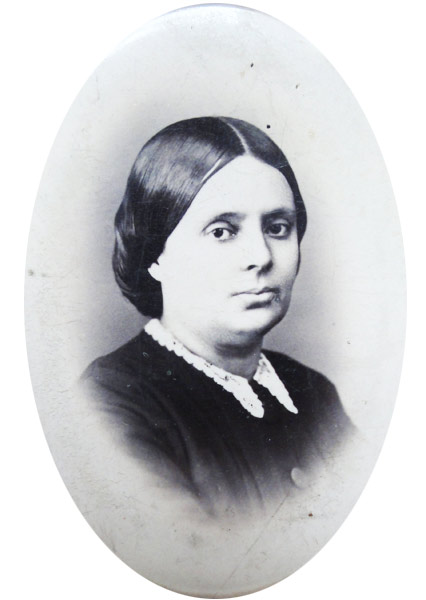
Maria Rosetti features in the Brătianu family correspondence, where she was described as “dark-skinned, not exactly beautiful, but with Mediterranean sex-appeal, expressive, passionate, artistic. (...) She wrote well, with romantic exaltation, she could bring out the beauty in everything she did and she spread it around her. She could decorate a room with only a few items and turn it into such a pleasant sight; she would cut the fabric for a dress while singing and she looked like she was playing: one expected to see it in shreds, but the result would be so stylish and then she would add a little trim to make it absolutely unique.” Constantin Daniel Rosenthal painted a portrait of Maria Rosetti, which is found in the National Museum of Art of Romania.
On her return to Bucharest, Maria Rosetti, together with her husband, put her energy into supporting the actions preparing the Union of the Principalities. She was instrumental in the effort to help the people affected by the famine of 1866-1867 and she was behind the organising of the remembrance celebrations at Putna, in 1871 and 1877. During the war of independence, she raised funds and established the hospital in Turnu-Măgurele. She founded the Women’s Committee, which helped her raise substantial amounts of money for the military and for hospitals. She made a name for herself as a writer and publicist and she advocated women’s emancipation in Romania. She was C. D. Rosenthal’s model for the painting România Revoluționară (Revolutionary Romania) in 1850. In Romanian history, she will go down as Maria. She was the first female journalist, who managed a Sunday magazine entitled Mama și copilul (Mother and Child), which she produced almost entirely single-handedly. After C. A. Rosetti’s death, she lived on Strada Doamnei, together with her son, Vintilă and his wife, on the same premises as the editorial house of the newspaper Românul (the Romanian) whose editor had been C. A. Rosetti. The building was in Emanoil Băleanu’s house, in Pasajul Român which was demolished in 1958. She died on 18 (some sources 25) February, 1893. Of their eight children, only four made it to adulthood: Libertatea, born on 6 June 1948, and three boys: Vintilă, Mircea and Horia.
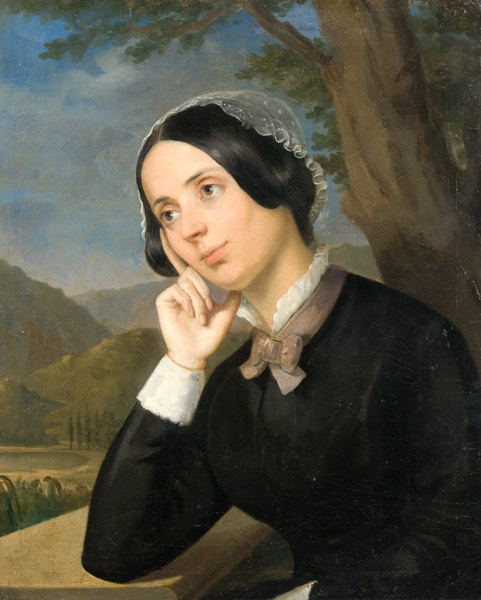
The streets named after the couple, C. A. Rosetti and Maria Rosetti, are situated in central Bucharest, linked at one end.
Effingham Grant, as secretary to the British Consul-General, fought for the lives and assets of the 1848 revolutionaries. His marriage to Zoe Racoviță on 28 October, 1850, was conducted according to Orthodox and Anglican traditions in two ceremonies. After Colquhoun’s departure (1859), Grant withdrew from diplomacy and stayed in Romania. He was the founder of the first Romanian family of repute, of English origin. One of the last descendants of the family, Maria Cristina (b. 1948) returned to England; there are no descendants from the paternal line of the family. The Golescu-Grant manor house, also known as Palatul Belvedere (Belvedere Palace) belonged to Dinicu Golescu, then to Effingham Grant and his wife Zoe (née Racoviță), granddaughter of the Golescus and sister of Anica Davila.
The Grant family owned Grădina Belvedere (Belvedere Gardens), Dinicu Golescu’s estate, which had been left to his daughter, Ana, married to Alexandru Racoviță who, in turn, passed it on to his daughter Zoe Racoviță who became E. Grant’s wife. This would later develop into a neighbourhood, a whole district known under the name of Grant - as far as Gara de Nord (the Northern Train Station), Giulești, the military hospital. This was also the place of the family home.
“Named after this Englishman (naturalised Romanian) who divided and sold the estate, this whole stretch of land, with all the buildings on it was, and still is, known as ‘Grant’.” (...) “Within this garden full of old trees and beautiful pathways, was the manor house: a real fortress, with thick walls, deep arched cellars, shuttered windows and a tunnel which led all the way to the bank of the river Dâmbovița, to be used in case of danger, as a quick escape to safety. The house, which had been renovated several times, was the summer residence of Dinicu Golescu’s family and their descendants. Bucharest, in the hot summer days of open plains, was like a burning furnace.” “Grădina Belvedere (Belvedere Gardens) stretched from Strada Ștefan Furtună, Bulevardul Dinicu Golescu, to the north and north-west, incorporating the whole Grant district, and almost as far as Giulești; part of this area is occupied today by the military hospital, the entire Gara de Nord (the Northern Train Station) and its neighbourhood, as far as the edge of the city.”
Of E. Grant’s children, worthy of notice are: Constantin Grant, a soldier in the war of independence, and then in the Foreign Legion, in Algeria and Nicolae Grant (1868-1950), an academic painter.
